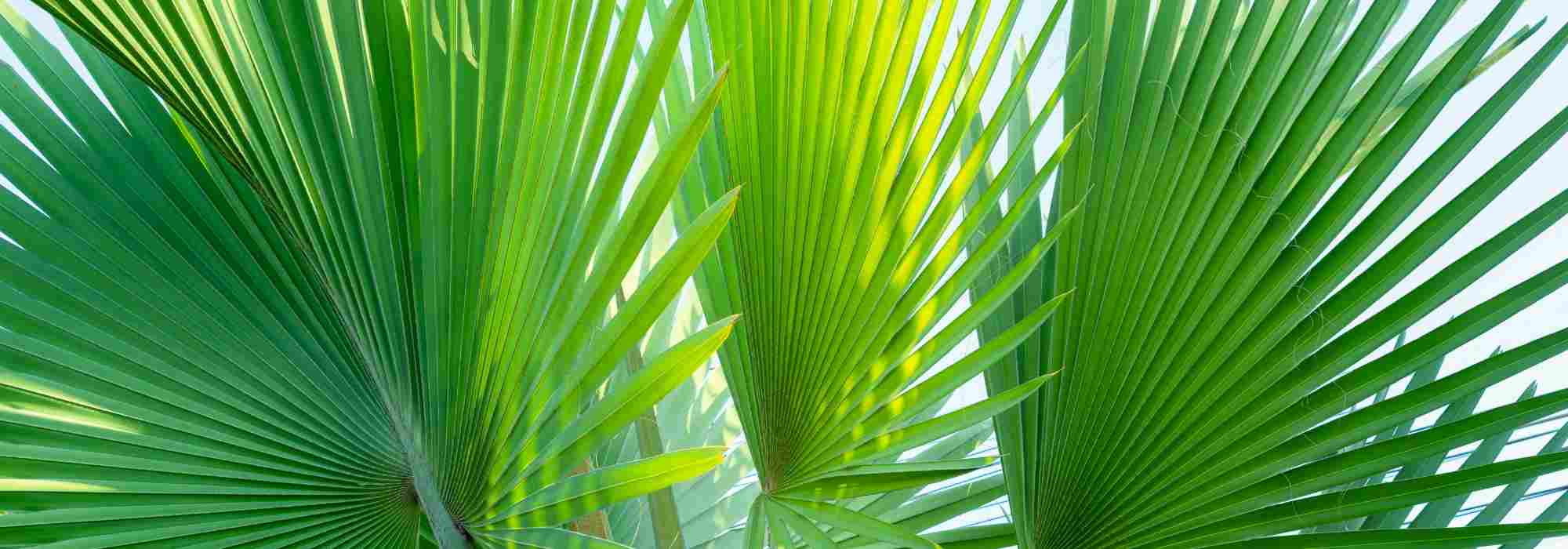
Pritchardia - Fan Palm: Planting and Growing
Contents
The Pritchardia in a few words
- The Pritchardia is a palm with palmate and plicate leaves
- Growing in the Pacific Islands, these palms are not hardy
- They should therefore be grown in pots indoors and taken outside in summer
- The Hawaiian palm and its botanical cousins prefer light shade
- Pritchardias thrive in rich and light soil and substrates
The word from our expert
Ah, Hawaii… Personally, this name conjures up images of brightly coloured floral shirts, white sandy beaches, and a tall, moustached fellow (from the old version!) being chased by two Dobermans named Zeus and Apollo… But the Hawaiian Islands and other Pacific islands are also, and above all, about a warm and humid atmosphere and volcanic soil that hosts a unique flora. Among this flora, we can mention the fan palms or Pritchardia.
The Pritchardia, or fan palm, develops on a long stipe, a sort of trunk, and unveils large leaves measuring nearly 2 metres in all directions, palmate and pleated like an accordion in the shape of a fan or a large spoon. Exotic vibes guaranteed!
But, as you’ve probably guessed, if these palms thrive in the Pacific, it’s best to forget about planting them directly in the ground in our gardens. No matter, we’ll welcome them indoors in pots. Pritchardias are content with a rich and light substrate and a bright exposure, without direct sunlight. In winter, these palms should remain at temperatures between 10°C and 15°C, for example in a conservatory. But nothing stops you from taking your Hawaiian palms outside in summer, in the garden, on the terrace, or on a balcony.
Very easy to grow, Pritchardias suffer little from diseases or pests and require minimal care apart from occasional watering and a bit of fertiliser. So don’t hesitate to take the plunge and welcome… a little piece of the Pacific islands into your conservatory.
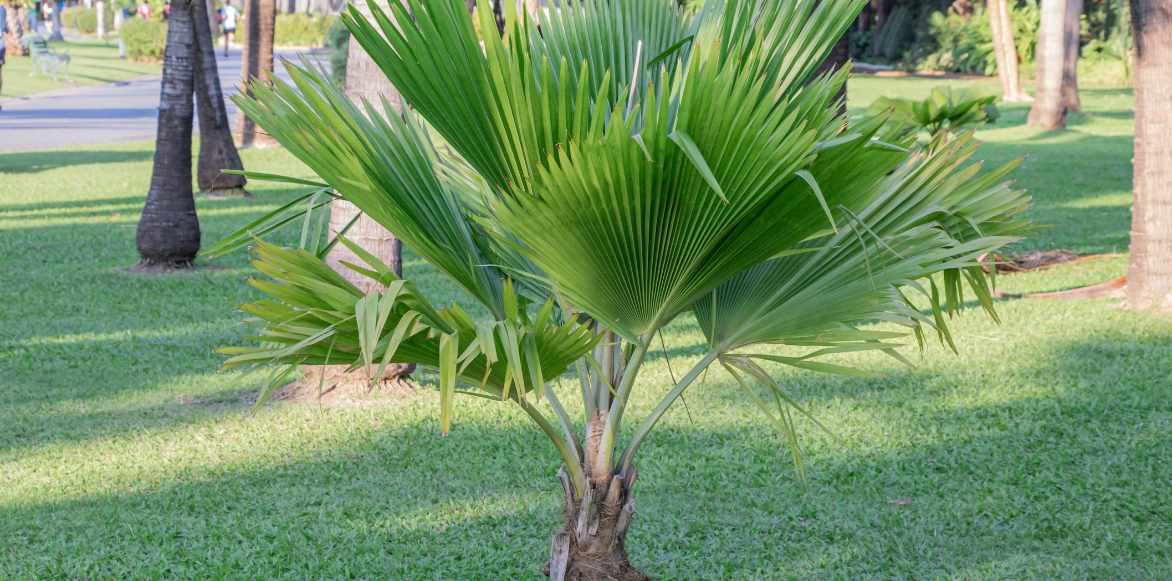
Pritchardia pacifica
Botany and description
Botanical data
- Latin name Pritchardia sp.
- Family Arecaceae
- Common name Hawaiian palm, Fan palm, Pacific fan palm
- Flowering July to August
- Height up to 40 m
- Sun exposure sun, partial shade
- Soil type rich and light, but moist
- Hardiness minimum 5°C
The genus Pritchardia, like all palms, belongs to the Arecaceae (or Palmae) family and includes 37 species of fan-leaved palms, such as Pritchardia pacifica from the Tonga and Fiji islands, as well as Pritchardia hillebrandii and Pritchardia remota from the Hawaiian islands. The common names for these palms include Fan palm, Hawaiian palm, Pacific fan palm, and even Spoon palm. The genus name Pritchardia refers to the British consul W.T. Pritchard, who resided in the Samoa and Fiji islands.
Pritchardia palms grow on volcanic soils and in the rainy regions of the Pacific. In their natural range, the islands of the Hawaiian archipelago (19 species of Pritchardia) and a few other Pacific islands (Fiji, Samoa, Tuamotu, and Tonga), Pritchardia palms can reach heights of up to 40 metres, with a trunk diameter of up to 50 cm.
Native to the Pacific islands, these palms cannot tolerate winter temperatures below 5°C. Therefore, they must be kept indoors during winter, in a lightly heated room with temperatures between 10°C and 15°C. As a result, these palms are best kept in pots year-round in our regions, but they can be moved outdoors to the garden during the warmer months.
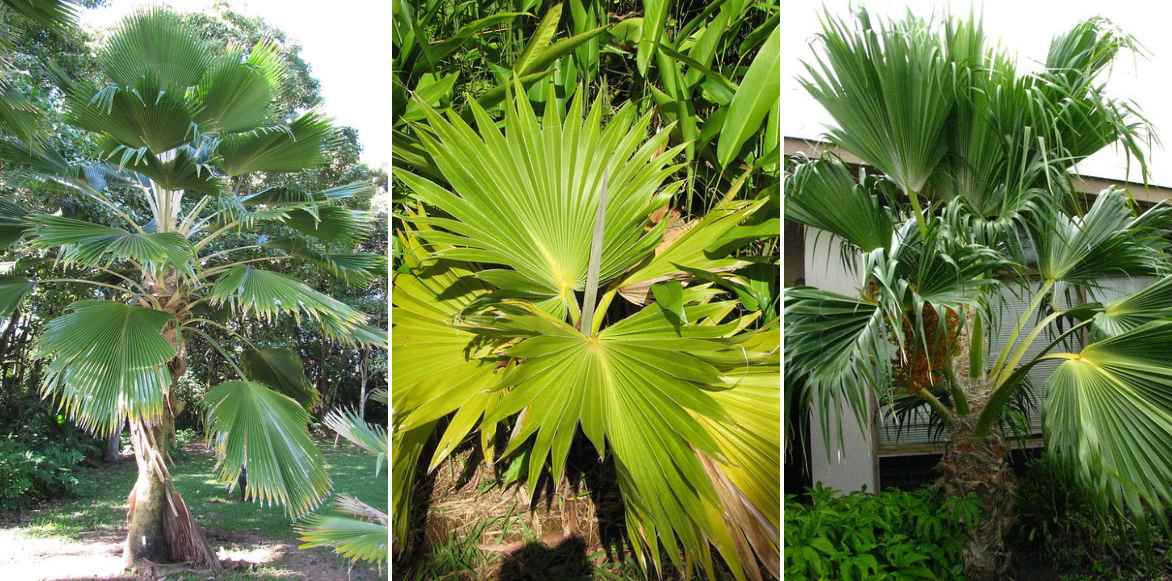
Pritchardia pacifica, Pritchardia hillebrandii (© Forest and Kim Starr), and Pritchardia remota (© David Eickhoff)
Pritchardia palms feature a long, solitary trunk (pseudo-trunk) several metres tall, either smooth and bare or covered in fibres. The trunk displays ringed scars.
The flowers appear between July and August. They are hermaphroditic, meaning they possess both male and female organs. The flowers are yellowish and fragrant. The inflorescence is arched, with simple or compound branches of varying lengths depending on the species, but always extending beyond the leaves. The fruits develop at the tips of these inflorescences. They are small black berries, 12 mm in diameter when ripe, each containing a single seed. Note that it takes about ten years of cultivation for the flowers and fruits to appear.
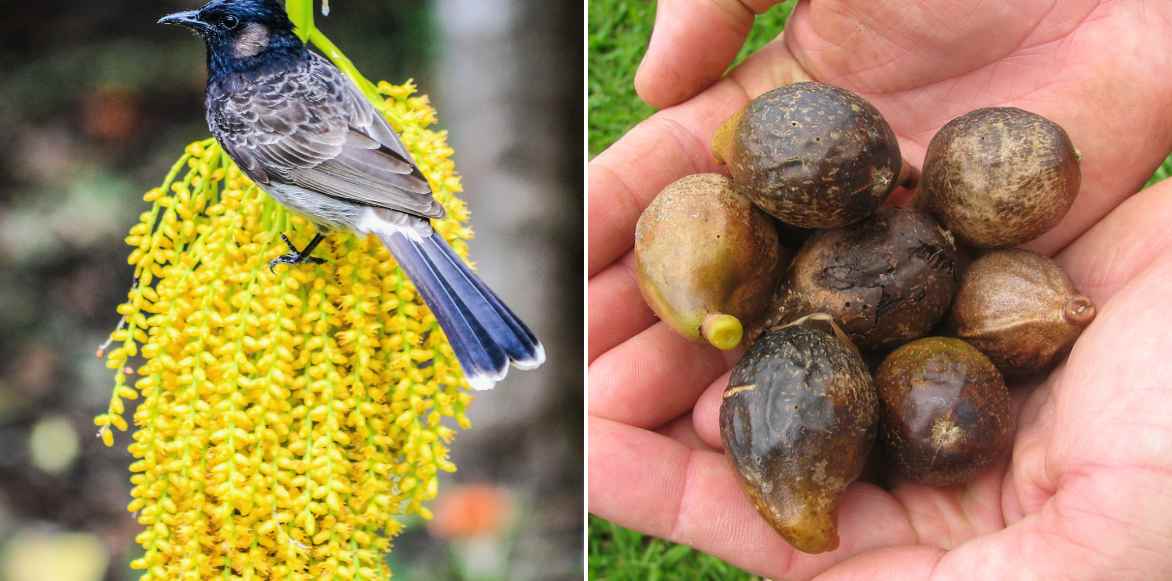
Flowers of Pritchardia, and the fruits of Pritchardia arecina (© Forest and Kim Starr)
The leaves are costapalmate (fan-shaped but with a central axis), arranged in a fan, pleated, and held by inermous petioles (without thorns) covered in tomentum (a kind of fuzz). Each leaf can measure up to 1.80 m in length and width. The fronds are green, ranging from light to dark, and waxy. The leaf sheath eventually breaks down into fibres.
Pritchardia palms are widely cultivated as houseplants. The growth of these palms is slow for the first two or three years but accelerates afterward, quickly producing a majestic specimen.
Some species of Pritchardia are listed on the IUCN Red List and are currently endangered.
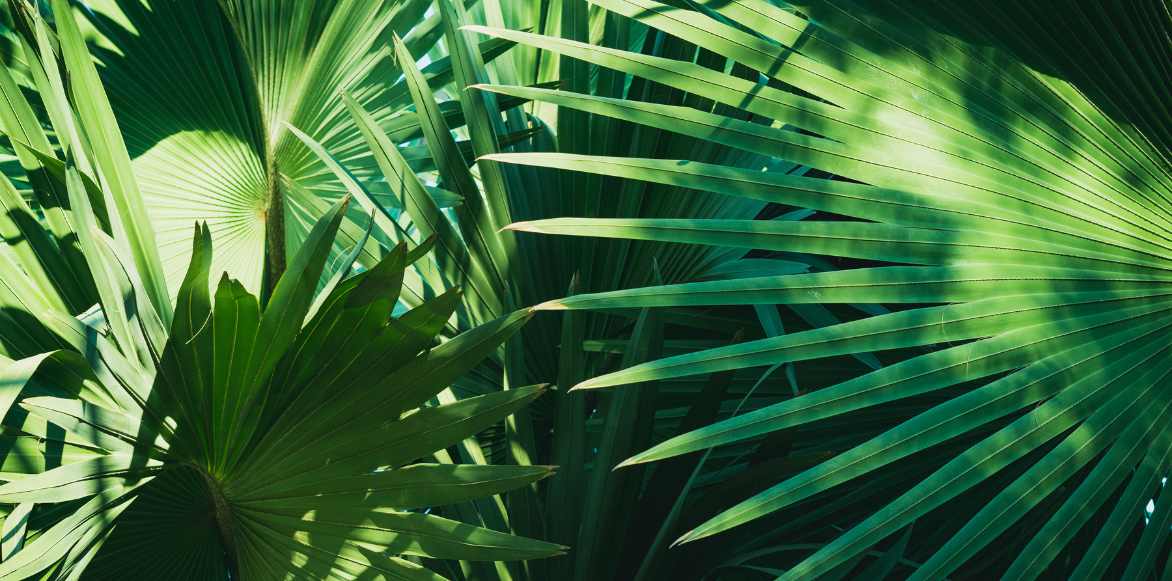
Leaves of Pritchardia pacifica
The most beautiful species of Fan Palm
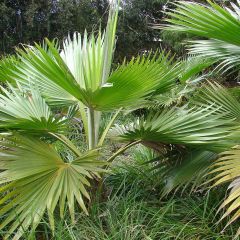
Pritchardia hillebrandii - Hillebrand's Fan Palm
- Flowering time August, September
- Height at maturity 2 m
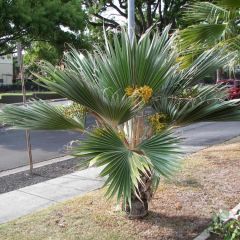
Pritchardia hillebrandii Blue Moon - Hillebrand's Fan Palm
- Flowering time August, September
- Height at maturity 2 m
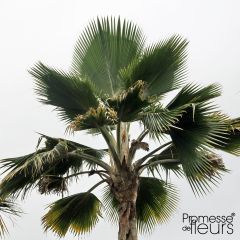
Pritchardia pacifica - Fiji Fan Palm
- Flowering time August, September
- Height at maturity 1,90 m
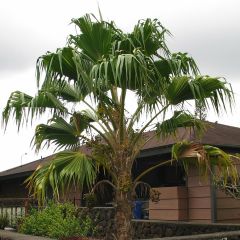
Pritchardia remota - Pritchardia Palm
- Flowering time August, September
- Height at maturity 4,50 m
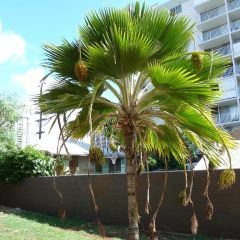
Pritchardia thurstonii - Pritchardia Palm
- Flowering time August, September
- Height at maturity 1,90 m
Discover other Pritchardia
View all →Available in 1 sizes
Available in 1 sizes
Available in 1 sizes
Available in 1 sizes
Available in 1 sizes
Planting Pritchardia
Where to Plant?
These palm trees are not hardy and cannot tolerate temperatures below 5°C. Therefore, they should be grown in pots as indoor plants. The winter temperature should ideally be between 10°C and 15°C, making a bright, minimally heated room like a conservatory the perfect spot.
Avoid direct sunlight, as it may scorch the fronds. Filtered sunlight is the most suitable exposure. You can move your Pritchardia outdoors during the summer, but always keep it sheltered from direct sunlight.
When to Plant?
The Pritchardia should be repotted between the months of May and July.
How to Plant?
Choose a large pot (at least 10 L) that is deeper than it is wide, as the roots of these palm trees grow vertically. Ideally, opt for a terracotta pot, which is more porous. The pot must have at least one drainage hole at the bottom.
The substrate should be rich and light. You can make your own by mixing 25% compost, 25% potting soil, 25% pumice, and 25% sand. Alternatively, ready-to-use Mediterranean plant compost or indoor plant composts are suitable.
- Soak the palm tree’s pot for a few minutes;
- Place pottery shards or a few gravel pieces at the bottom of the pot to cover without blocking the drainage hole(s);
- Fill one-third of the pot with the chosen substrate;
- Place the root ball in the centre, then fill the gaps with the remaining substrate;
- Firmly press the substrate around the trunk with your fingers;
- Water thoroughly until saturated: this will help minimise any potential “gaps” between the substrate and the roots;
- Place your palm tree in partial shade, indoors or outdoors if the temperature allows.
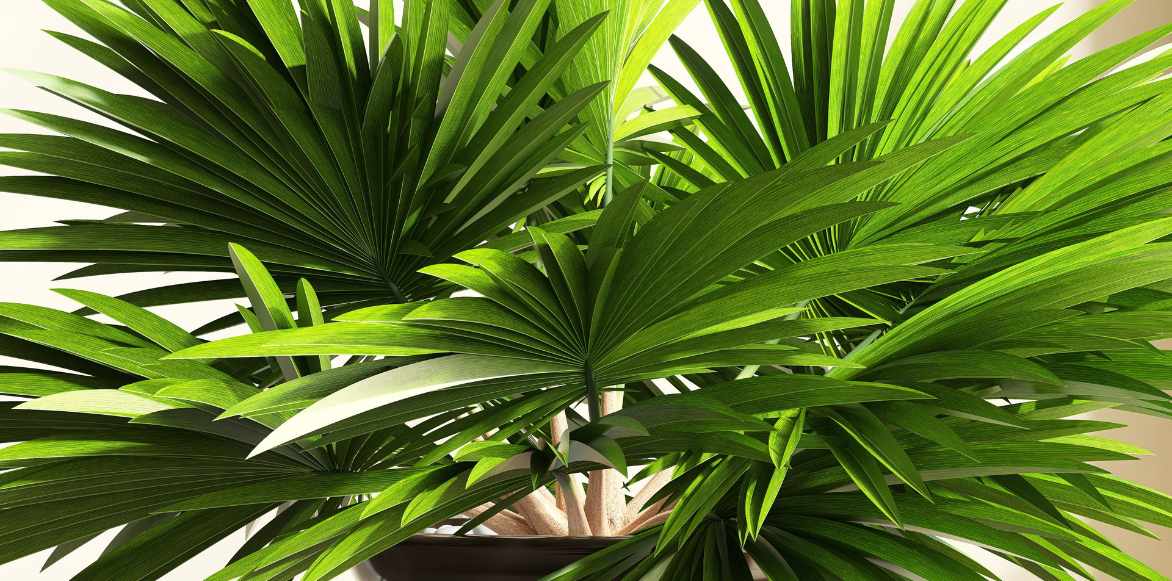
Pritchardia pacifica grown in a pot
Maintenance
Watering
Water regularly from June to September to keep the substrate slightly moist, without overdoing it. Reduce the amount of water outside these months: you can let the top layer of the substrate dry out.
Avoid heat sources and direct sunlight, which can dry out or scorch the fronds. Place the pot on a bed of gravel or clay balls kept moist. You can also spray non-calcareous water daily to increase humidity for the plant, especially in dry indoor environments.
Pruning
Only remove yellowing leaves! Over-pruning a palm often slows its growth.
Maintenance
Clean the fronds frequently with a damp sponge to remove dust.
Feeding
A liquid “green plant” fertiliser, well-balanced in nitrogen (at least 6 in nitrogen), is the most suitable. Apply it monthly between April and September.
You can also add some crushed horn during spring repotting for plants that are a few years old.
Possible diseases and pests
Scale insects can sometimes infest indoor palm trees. Greasy products are effective against scale insects. You will need to prepare a solution made of one teaspoon of liquid black soap and one teaspoon of olive or rapeseed oil, all diluted in one litre of water. You can spray this mixture weekly until the scale insects disappear.
Scale insects thrive in warm, dry, and confined spaces: taking your palm tree outside (if the temperature allows!) and exposing it to wind and rain will help effectively combat these pests.
→ Are scale insects causing you trouble? Discover how to effectively and naturally combat these pests!
Multiply the Pritchardia
Palm trees are propagated by sowing. You can sow Pritchardia seeds all year round indoors, in a warm and humid atmosphere.
- First, soak your seeds in lukewarm water for at least 24 hours. This aids germination;
- Prepare pots by filling them with a well-draining substrate, for example, a mix of 1/3 compost and 2/3 sand. Choose pots that are tall enough (at least 2 L), as in some species, the first radicles that appear penetrate deeply into the substrate;
- Remove the seeds from the water, rinse them, and sow them in your pots;
- Cover them with a thin layer of substrate;
- Gently press down with your fingers;
- Water with a fine spray;
- Place a lid or plastic bag over the pot to maintain a humid atmosphere;
- Position your sowings in a bright location, but out of direct sunlight, and at a temperature of at least 20°C.
How to pair the Fan Palm?
Even if it remains in a pot and spends part of the year in a conservatory or cold greenhouse, the Pritchardia, for example a Pritchardia hillebrandii, can be placed in partial shade during summer and paired with lush, exotic-looking plants in the garden. Examples include the Tetrapanax papyrifera, the Banana plant Musa basjoo, or the Elephant Ear Colocasia ‘Pink China’… If you have a water feature or very damp soil, you could plant the Gunnera manicata or even tree ferns.
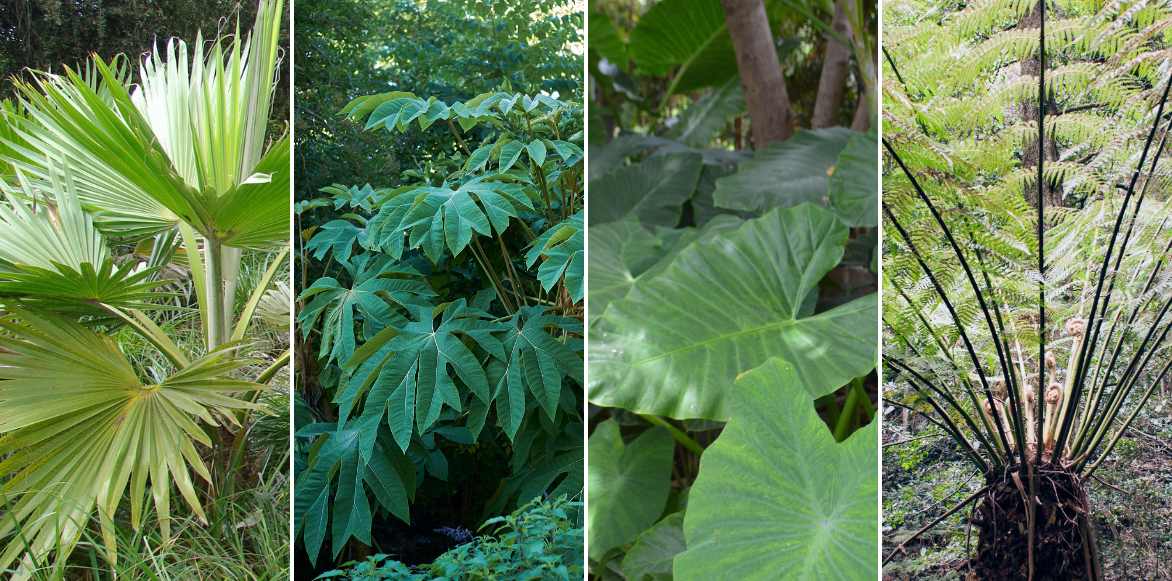
Pritchardia hillebrandii (© Forest and Kim Starr), Tetrapanax papyrifera, Colocasia and Dicksonia antarctica
However, the highly graphic nature of these palms also makes them very valuable on a terrace or balcony in summer. If space allows, you could pair a Pritchardia thurstonii with a Dasylirion glaucophyllum, a large rosette of blue-green linear leaves borne on a short trunk. A small tree widely found in the tropics, the Frangipani or Plumeria rubra will add a colourful and fragrant touch with its pretty pink or red flowers. Finally, if part of the terrace is well-shaded, you could try another rather surprising palm, the Parlour Palm, with its very green bifid leaves.
Also read...
→ Discover our most beautiful Pritchardia in our online nursery.
To learn more about palm trees in general:
- Palm trees: sowing, planting, and care
- The website of the Palm Tree Enthusiasts association, with a forum
- Book: Understanding Palm Trees, by Pierre-Olivier Albano, published in 2002 by Edisud
- For prevention and treatment: Diseases and parasitic issues in palm trees
- Subscribe!
- Contents




































Comments